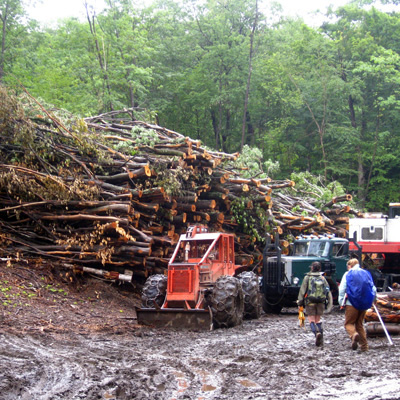Wood Bioenergy Harvesting Impacts on Carbon Emissions in the Northeast
Oct. 28th 2014Demand for forest bioenergy, or biomass, (firewood, wood chips, pellets) is increasing in Vermont and the Northeast. Yet, ecological impacts and greenhouse gas (carbon) emissions associated with wood bioenergy harvests remain uncertain and actively under debate. For example, recently, two groups of scientists sent competing letters to the U.S. Environmental Protection Agency. The crux of the debate comes down to whether or not there will be an initial increase in greenhouse gas emissions if more wood is used for bioenergy (a carbon “debt”), particularly if it is harvested from growing forests, followed by a delay before a net emissions reduction is achieved (the “dividend”). And if so, how long would that delay be? To explore the points in contention, researchers from the University of Vermont, with support from the Northeastern States Research Cooperative, used computer models to simulate the net carbon emissions that would happen if wood energy harvesting were to expand across the northern forest landscape. Using a novel approach, William Keeton, Anna Mika, and Caitlin Littlefield used field data from real bioenergy operations to generate a variety of bioenergy harvesting scenarios, comparing these, also to non-bioenergy harvests. Employing a full carbon accounting approach that tracked all direct, indirect, and avoided emissions, they applied these harvest scenarios to 362 actual forest sites in New York, Vermont, New Hampshire, and Maine and projected growth and harvests over 160 years using a computer model called the Forest Vegetation Simulator. Unlike previous studies, the simulated harvests were staggered over time and space, and modeled as integrated harvests that also produce other kinds of products, to better approximate the way real forested landscapes are managed. This is where it got complicated. When looking at bioenergy harvests and energy production across the Northeast, the researchers came to completely different conclusions depending on which of two baselines they used as a reference to evaluate net emissions. The results showed long-term, net emissions increases for all the bioenergy scenarios if the baseline used was the amount of carbon that would have been sequestered had wood bioenergy not been used (with all other things being equal and taking into account avoided emissions and direct and indirect energy uses associated with wood harvesting). Think of this as the opportunity cost, or foregone carbon sequestration potential, of forests managed less intensively without a lot of additional harvesting pressure. Carbon (C) emissions in units of megagrams (Mg), or metric tons, per hectare increased with increasing percentage of landscape harvested for bioenergy:
- 25% of the landscape harvested resulted in an average annual emission of 2.47 Mg C/hectare;
- 50% of the landscape harvested resulted in an average annual emission of 5.02 Mg C/hectare;
- 100% of the landscape harvested resulted in an average annual emission of 9.83 Mg C/hectare.
The researchers reached an entirely different conclusion if the baseline was simply the amount of carbon being emitted at the present date. Using current emissions as the point of reference, then most forest management schemes, including wood bioenergy, lowered net carbon emissions over the long-term. This was true so long as forests were managed following principles of sustainable harvest scheduling that maintain stable stocks of forest carbon across the landscape as a whole. So, assuming there will be some degree of carbon debt in the near future and a consequent time lag before an overall net reduction of emissions, the researchers suggest we can minimize both by following certain practices:
- using by-product or waste biomass, that does not involve intensive forest harvesting;
- practicing rigorous, sustainable forestry techniques that retain elements of stand structure post-harvest;
- building small-scale, highly efficient energy generation applications with minimal waste;
- using bioenergy for heating which decreases carbon emission relative to electricity generation; and
- establishing unharvested forest reserves to help offset carbon emissions from harvested stands.
These findings and recommendations should help guide forest managers and renewable energy policymakers to plan for future bioenergy needs in the Northeast. If we are going to invest in and promote wood bioenergy, the researchers suggest that we should proceed with caution, using the best available science. Policymakers will need to weigh the benefits and trade-offs to minimize unintended consequences such as emissions increasing in the short-term. Getting this right is vital, because we have a window of only the next few decades to stabilize atmospheric greenhouse gases, beyond which some scientists believe climate disruption will be irreversible.
 ecoNEWS VT
ecoNEWS VT